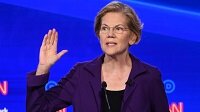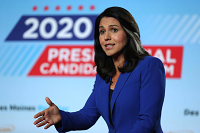2020 Presidential Candidates Plans to Tackle Consumers Debt
I received my monthly bill for my student loans the other day with the total of that bill being 80 percent of my income. My student loan payments equal almost the full amount of what I make each month, and that is just in interest. That is not even going toward the principle for the loans to shrink in any way. I would love to know who can afford to pay out 80 percent of their income to bills? Definitely no one that I know, especially not those that have had zero success finding work in their field.
The student loan debt crisis has been a popular topic for quite some time, and with good reason. With Americans owing almost $2 trillion in student loan debt, it is a tough subject to ignore. With the 2020 Presidential race going strong, it is no surprise to see the majority of candidates offering their idea of a solution for this problem. In order for any of the plans to work, the candidate and the voters need to understand this problem on a deeper level.
The Foundation of the Student Loan Crisis
Those who have not experienced student loan debt first hand do not fully comprehend it. They view it a lot like any other debt- a credit card bill or car insurance. Student loan debt, though, is totally different.
I have listened to a lot of people weigh in on this subject and have been surprised by most of the conversations. There are many people who assume that borrowers just are not paying their bills, or that they cannot afford the payments because they are not putting their degree to use. They wonder why America should “dig these people out of debt that they put themselves in”.
People Cannot Afford to Pay off Their Student Loan Debt
As a person who is in over $100,000 of student loan debt, these conversations make me want to scream. I attended college with the hopes and dreams of getting a good job and making decent money. After an undergraduate and graduate degree, I am still not fulfilling that goal, and it is not from lack of trying. Sadly, even after five years of college, I was told I only qualify for entry-level positions. It turned out that I made more money waiting tables.
You see, what college students are not told is that a degree does not guarantee a better life. After you have received that $100,000 piece of paper, you still have a long way to go, and most graduates are not prepared for it. Many for-profit schools are interested only in lining their own pockets- not in the success of students. In fact, many of them have been accused of defrauding students.
And many college graduates learn too late that they actually are not qualified for the positions they seek for a number of reasons. It may be a lack of quality education due to poor funding of the institution or a lack of commitment from the schools to see their students succeed or many other things.
Bottom line: most degree recipients are not making enough money to repay those loans. If we really want to deal with this student debt crisis, the focus has to be spread among several things. Part of dealing with it definitely should involve working on interest rates, payment caps, repayment programs, and so on.
However, it is also vitally important that the quality of education and training be addressed to prevent this same crisis from reoccurring.
You Can Pay Off Debt Sooner with the Right Tools. Debtry Can Help.
Presidential Candidates Deal with the Student Loan Crisis
Let’s take a look at the 2020 presidential candidates and their plans to solve this crisis.
Donald Trump
Image Source: New York Post
Donald Trump
Current President Donald Trump has already attempted to make moves that affect the country’s student debt crisis, some that have passed and some that have not. He is still working toward many of the same moves and some modified ones. His ideas of student loan debt include the following:
An increase in investment of workforce development and job training
Higher potential of disabled veterans receiving loan forgiveness
Eliminating the current income-driven repayment plans and replacing them with only one option- a plan with payments of up to 12.5 percent of a borrower’s income
Complete elimination of the Public Service Loan Forgiveness program
Elimination of subsidized loans- loans given to low-income students that do not accrue interest for a set period of time
Cutting the Department of Education funding by 10 percent
Elizabeth Warren
Image Source: CNBC
Elizabeth Warren
Senator Elizabeth Warren is rather bold with her plan to tackle consumer debt as she aims to ease the pressure on the less fortunate and spread it among the more fortunate. Her proposal includes the following:
Expansion of the Pell Grant program so that those who need it can graduate without debt
Providing tuition-free two and four-year public college for all
Student loan debt elimination of up to $50,000 in federal student loans for borrowers whose annual household income is less than $100,000
Partially forgiving federal student loans for borrowers whose annual household income is between $100,000 and $250,000
Paying for these plans by implementing a 2 percent annual tax on families who hold $50 million and up
Michael Bloomberg
Image Source: CNBC
Michael Bloomberg
Michael Bloomberg has not at this point shared any official plan to tackle consumer debt. However, we can probably assume due to his previous and current actions that he is supportive of the less fortunate getting quality education. He has donated almost $2 billion to support financial aid at Johns Hopkins. He feels that a student’s entrance into a school should not be decided by the student’s financial status and ability to pay.
Joe Biden
Former Vice President Joe Biden has laid out his $750 billion plan to tackle consumer debt with the following steps:
Joe Biden
Image Source: cfr.org
Two years of community college should be tuition-free
Invest in college business partnerships and apprenticeships
Increase Pell Grant awards to twice the current amount
Create grants that community colleges can use to increase the success of their graduates
Invest in the overall physical improvement of community college facilities
Invest in Historically Black Colleges and Minority-Serving Institutions
Allow student loan borrowers working in public service to receive $10,000 in loan forgiveness each year for a maximum of 5 years
Borrowers who make less than $25,000 a year are eligible to decrease their payments all the way down to zero while not accruing any interest
Borrowers with an income of over $25,000 a year would pay half of the current amount required
Amy Klobuchar
Image Source: New York Times
Amy Klobuchar
Senator Amy Klobuchar does not believe that the answer to the student loan debt crisis is providing completely free college. However, she is highly in favor of supporting steps to reduce student debt. Her plan to tackle consumer debt is:
Providing free community college for two years
Allowing 529 savings to be redirected to training programs instead of just college, giving young people more options
Increasing loan forgiveness for those working in the public service sector
Supporting states to provide small grants to students in need
Increasing Pell Grant awards to $12,000 per year
Supporting income-based repayment plans and student loan refinancing with interest rates at about 3 percent
Making college more accessible to veterans, parents, the homeless, and other minority or underserved groups
Allowing the cancellation of loans for students who have been defrauded by the colleges they attended
Supporting the investment of career services and training as well as STEM education
Pete Buttigieg
Image Source: gettyimages
Pete Buttigieg
Mayor Peter Buttigieg has his own experience with crushing student loans. His plan to tackle consumers debt is to:
Expand the amount of Pell Grant awards so that they are in line with inflation and help cover living expenses
Put greater accountability on for-profit schools
Invest $50 billion in Historically Black Colleges and Minority-Serving Institutions and $500 billion into overall higher education- providing college tuition-free for many low-income students
Allow debt cancellation for borrowers of “unaffordable for-profit programs”
Bill Weld
Image Source: Pxfuel
Bill Weld
Republican Bill Weld states that student debt will be a top priority should he win the election. Some of his ideas are to:
Support a federal student loan refinancing option
Decrease the overall cost of college
Bernie Sanders
Senator Bernie Sanders feels that the student loan debt crisis is affecting much more than just the borrower. Sanders believes that if the current student loan debt were eradicated, borrowers would be able to purchase homes and make business moves that would stimulate and improve the country’s overall economy, meaning everyone benefits. His bold plan to tackle consumers debt is to:
Bernie Sanders
Image Source: The Nation
Cancel every dime of outstanding student debt
Invest in Historically Black Colleges
Wipe out all college tuition so that young people can get a good education to get good jobs in the future
Increase funding of the federal work-study program
Decreasing loan interest rates to 1.88 percent or less
Continue pushing his College for All Act through increasing Pell Grants and having states cover degrees for low-income families
Keep the federal government from profiting on student loans
Joe Walsh
Image Source: Fourteen East Magazine
Joe Walsh
Former Representative Joe Walsh has not yet revealed a plan for tackling student debt. However, as it was recently disclosed that he was still in student loan debt until he left Congress, it would not be shocking for him to announce some type of action plan with big moves.
John Delaney
John Delaney
Image Source: CNBC
Representative John Delany’s plan to tackle consumer debt is geared toward making college and student loans more affordable as opposed to eradicating the current debt. He aims to:
Provide either free career training or two free years of community college
Expand the Pell Grant program
Shorten the repayment terms on income-driven repayment, meaning forgiveness happens two years earlier than it does now
Reduce interest on federal student loans
Allow up to $27,000 in federal student loans to be refinanced for more affordable terms and interest rates
Make federal and private loans eligible to be discharged for those filing bankruptcy
Andrew Yang
Image Source: The Verge
Andrew Yang
Andrew Yang, a recipient of student loans himself, so he knows first hand how the debt can affect students. Thanks to his personal experience, he has come up with quite a plan to tackle consumer debt. It involves:
Making student loans eligible for discharge for those filing bankruptcy
The “10 x 10 Student Loan Emancipation Act”- borrowers pay 10 percent or less of their income for 10 years, after which any remaining debt is forgiven
Expand loan forgiveness for those who work in underserved areas
Attempt to get colleges to forgive the loans of students who do not graduate
The government should close colleges and other institutions whose graduates show poor employment and/or have a high rate of students that default on loans, hopefully encouraging institutions to be more committed to student success
Legally prosecute any for-profit schools proven to have misled students
Consider forgiving everyone’s student loan debt after a set period- 30 years has been the most common mentioned
Have the government buy private student loans, making it easier on borrowers to repay or qualify for forgiveness on those as well
Tulsi Gabbard
Image Source: The Wrap
Tulsi Gabbard
Representative Tulsi Gabbard is in favor of providing a free college education to American citizens, though she feels strongly against providing it for undocumented students. Gabbard is a combat veteran, so she knows first hand that loan forgiveness programs for vets were too stringent. She has worked to decrease the amount of time a veteran has to be deployed in order to receive Perkins Loan forgiveness.
Michael Bennet
Image Source: Wikipedia
Michael Bennet
Senator Michael Bennet has been working toward debt-free college for years, so it is no surprise that part of his plan to tackle consumer debt carries on that work. He actually has many goals concerning consumer debt which include:
That federal and state governments work together to make college more affordable
Make community college free to all
Give low and middle-income families a debt-free four-year education
Provide a federal student loan refinancing program so borrowers might qualify for a lower interest rate
Make student loans eligible to be discharged through bankruptcy
Expand the Pell Grant program
Have external entities collect data on how graduates from different colleges actually do, making it more transparent which colleges are worth the time to attend and which should be avoided
Use this collected data to determine which schools should no longer receive financial aid- the goal of this is to make colleges more accountable and actually vested in their students’ success
Expand the loan forgiveness program for public service workers
Make sure that student loan payments do not exceed 8 percent of the borrower’s income
Forgive loans after the borrower has made payments on time for 20 years
Fund the creation of career training and apprenticeships to support citizens in qualifying for good jobs
Deval Patrick
Image Source: gettyimages
Deval Patrick
Deval Patrick has not yet shared an exact plan to tackle consumer debt at this time, but he is in agreement that something must be done about the level of student loan debt this country is in. He has been vocal in the fact that he is not in favor of Elizabeth Warren’s and Bernie Sanders’s mass forgiveness of said debt. As governor, Patrick has supported free two-year community college and making it easier for community college credits to be transferred to universities.
As many community college students have to retake a lot of classes due to credits not transferring, they are double charged for earning the same credits. If Patrick is successful in getting credits transferred, there will definitely be a decrease in student loan debt in the future.
Tom Steyer
Image Source: New York Post
Tom Steyer
Though Tom Steyer has not laid out a specific plan to tackle consumer debt, he has been vocal in his support of the government making sure that Americans have access to free, quality education and skills training.
Conclusion
There is never any certainty in politics, and there is no way of knowing whose plan will work best until that plan is active. Each candidate has his or her own ideas on what the best solution is. While no one knows the future, I firmly believe that this problem needs to be dealt with at the root- the education system- and at the fruit- the debt that it has produced.
Dealing with just one or the other will only lead to a never-ending cycle of cause and effect. Those of us buried under student loan debt hope that whoever is chosen for president in 2020 can break this negative cycle and make a positive change before the next generation of college students find themselves in the same position we are in.

















